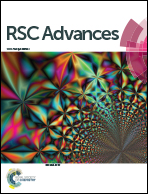Graphene oxide reinforced Ni–P coatings for bacterial adhesion inhibition†
Abstract
Bacterial adhesion on the surfaces of medical devices, food processing equipment, heat exchangers and ship hulls has been recognized as a widespread problem. Bacterial adhesion on a surface is influenced by surface physical and chemical properties of the surface. In this paper, polyethyleneimine (PEI) grafted graphene oxide (GO) nanosheets were incorporated into Ni–P coatings by an electroless plating technique to modify the surface energy, and therefore to influence the interactions between the prepared surfaces and the tested bacteria. Ni–P–GO coatings were investigated by SEM, AFM, Raman spectrum and XPS. Contact angles of Ni–P–GO coatings with different GO loadings were tested and the surface free energies and their dispersive and polar components were calculated using the van Oss acid–base approach. The results showed that the surface free energies of the coatings had a significant influence on S. aureus adhesion. The Ni–P–GO coatings showed excellent antibacterial adhesion activity. Extended DLVO theory is used to explain the antibacterial adhesion behavior. The novel coatings reported here can be used in controlling bacterial adhesion and biofilm formation for various applications.


 Please wait while we load your content...
Please wait while we load your content...